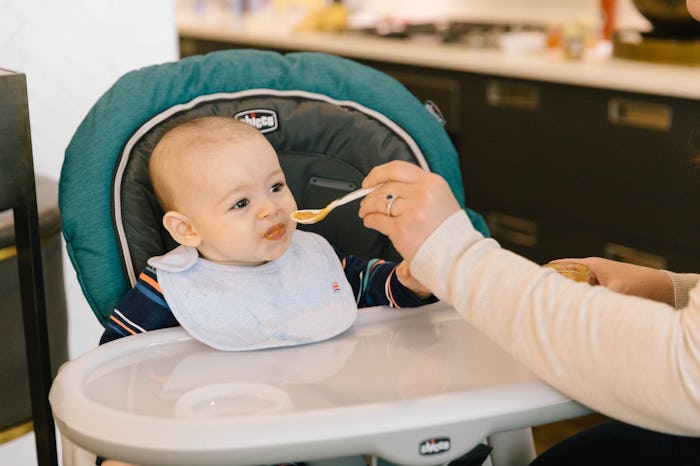Life
If You’re Thawing Frozen Baby Food At Room Temperature, You Need To Stop
So, you've decided to take the time out to make your baby fresh, homemade baby food. Feeding your baby fresh fruits, veggies, grains, and protein without any added preservatives and chemicals is healthier for your baby, and can make you feel good about meal time. But because it can be tedious to purée food everyday, you may want to make a lot and freeze it to use when you need it. But you may have concerns about how to safely thaw your food, so that it doesn’t spoil or overcook. What’s the best way to thaw homemade baby food?
Food safety, especially when it comes to babies, is really important, because when foods are not stored or thawed properly, bacteria can grow. Food safety expert and microbiologist, Irrem Jamal M.Sc, tells Romper that how you thaw your homemade baby food depends on how you freeze it. “There are different methods of safe thawing that include a stovetop, microwave, or submersion in hot water," explains Jamal.
She suggests that when you are freezing your homemade baby food, you do it in small portions. If your portions are too big, Jamal says it will take longer to thaw them, and if you have any leftover, it’s not a good practice to refreeze it. For food safety purposes, Jamal suggests using thawed fruits and veggies within two days (when stored in a refrigerator), and thawed meats and poultry within one day (stored in a refrigerator), and discarding any eaten portions right away.
Jamal says that one really great way to freeze and thaw your baby food is to fill ice cube trays with the purée and freeze them. Once frozen, you can store the cubes in resealable bags or in storage containers. This way, suggests Jamal, you will have easy-to-thaw portion sizes that you can safely defrost as needed. To thaw the frozen cubes, Jamal suggests placing them in the refrigerator overnight, but if you’re in a hurry, she says you can warm them over the stovetop, or put them in the microwave on a defrost setting in a microwave safe dish.
According to Momtastic’s Wholesome Baby Food, another easy and safe way to freeze and defrost your homemade baby food is to store portions in a freezer safe bag, and then when needed, you can submerge the bag in warm water for 10 to 20 minutes. The website further mentioned that it isn’t necessary for baby food to be really warm, because most babies have no problem enjoying room temperature food.
While using a refrigerator, microwave, stove top, or water bath to thaw are perfectly safe ways to thaw baby foods, Jamal explains that there is one method that you should not use. “You should avoid thawing foods at room temperature,” warns Jamal, “because room temperature foods can become breeding grounds for bacteria.” She says you should also not allow frozen baby foods to sit in standing water all day, again due to the risk of growing germs and bacteria.
Just to be on the safe side, Food Safety recommended labeling and dating your homemade baby foods, so that you can keep track of how long it’s been frozen. They also noted that homemade baby foods can be safely stored for up to a month in the freezer.
So depending on how you store it, in cubes, bags, or container, you can easily thaw your baby food on your stove, in your fridge, or in your microwave. As long as you follow all the food safety precautions, and avoid thawing at room temperature, you can safely feed your baby all that homemade goodness you worked so hard to make.
Check out Romper's new video series, Romper's Doula Diaries:
Watch full episodes of Romper's Doula Diaries on Facebook Watch.
